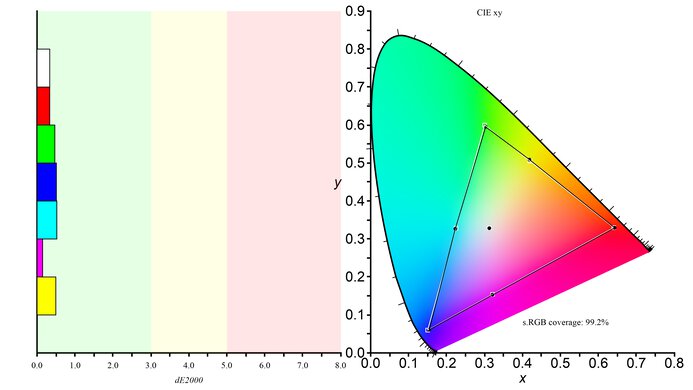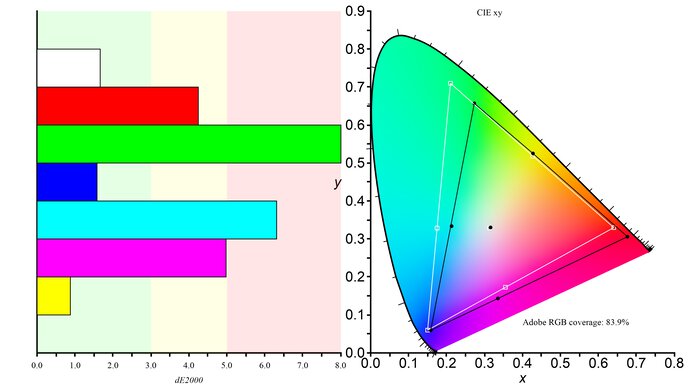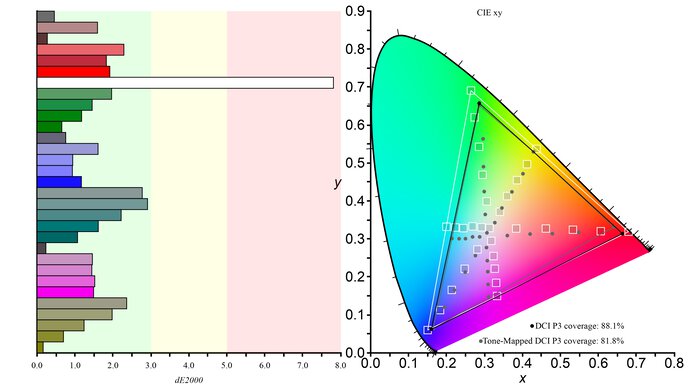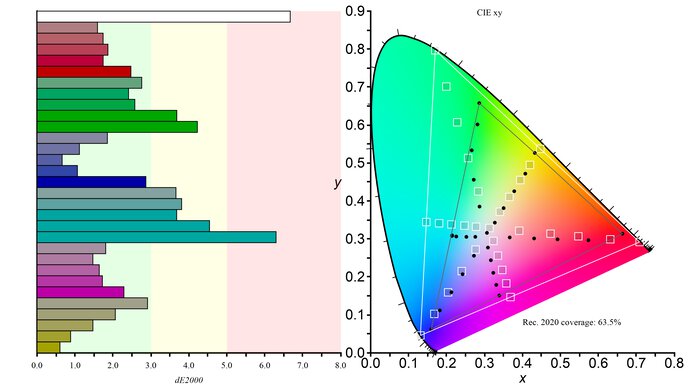The ASUS ROG Swift Pro PG248QP is a 24-inch flagship esports gaming monitor designed to meet the needs of competitive gamers. Its 1080p E-TN panel, designed specifically for esports, has an extremely fast 540Hz refresh rate, FreeSync, and native G-SYNC variable refresh rate (VRR) support. It has several gaming-focused features, including NVIDIA ULMB 2, which NVIDIA claims reduces image duplication, and NVIDIA Reflex Analyzer, which measures the latency of the individual parts of your gaming setup. It also has retractable stand legs, allowing you to reduce the stand's footprint.
Our Verdict
The ASUS ROG Swift Pro PG248QP is a very good PC gaming monitor. It has a remarkable 540Hz maximum refresh rate with VRR support to reduce screen tearing. It also has fantastic motion handling across its VRR range for sharp motion, and it has low input lag for a responsive feel. There isn't any noticeable VRR flicker with changing frame rates either, which is great if your PC can't maintain consistent frame rates. On the downside, it has limited picture quality due to its low contrast ratio and 1080p resolution, so it isn't a good choice if you like playing graphically intense games.
-
Extremely high 540Hz refresh rate.
-
Supports native G-SYNC.
-
Low input lag.
-
Backlight strobing has minimal image duplication.
-
Maintains fast response time across VRR range.
-
HDR highlights don't pop.
-
Mediocre contrast ratio.
-
No backlight strobing below 360Hz.
The ASUS PG248QP is disappointing for console gaming. With a 1080p resolution, it can't take advantage of the PS5 or Xbox Series X|S. It also delivers limited picture quality in HDR and SDR, as blacks look gray, and it doesn't get bright enough to provide vivid colors. That said, it still offers good enough pure gaming performance with a fast response time for sharp motion and low input lag for a responsive feel.
-
Low input lag.
-
Fast response time at 120Hz and 60Hz.
-
HDR highlights don't pop.
-
Mediocre contrast ratio.
-
Low 1080p resolution.
-
Limited console compatibility.
The ASUS ROG Swift Pro PG248QP is decent for office use. Its smaller 24-inch size and 1080p resolution make multitasking more challenging, and the text has only decent sharpness. Additionally, it has very narrow viewing angles, so the image appears washed out from the sides, making it more difficult to share your screen with another person. However, it has great brightness and decent reflection handling, so it overcomes glare in most environments. It also has very good ergonomics, so you can adjust the monitor to your preferred position.
-
Very good ergonomics.
-
Overcomes glare in most environments.
-
Narrow viewing angles.
-
Low 1080p resolution.
The ASUS ROG Swift Pro PG248QP is okay for content creation. It has very good ergonomics, so you can adjust it to your preferred position. However, its 24-inch size and 1080p resolution provide minimal space for multitasking, and its narrow viewing angles make it challenging to share your work with others, as they'll see a washed-out image from the side. Its color accuracy before calibration is also mediocre, so you'll need to calibrate it for the most accurate colors.
-
Very good ergonomics.
-
Overcomes glare in most environments.
-
Narrow viewing angles.
-
Needs calibration for most accurate colors.
-
Mediocre contrast ratio.
-
Low 1080p resolution.
The ASUS PG248QP has decent brightness. It gets bright enough to fight glare if you want to use it in a well-lit room, but it struggles to make highlights stand out in HDR.
-
Overcomes glare in most environments.
-
HDR highlights don't pop.
The ASUS PG248QP has a fantastic response time. It has incredible motion handling across its VRR range, and it also has amazing refresh rate compliance, meaning its response time is fast enough for 120 fps and 60 fps sources. Although its response time is slower at 60Hz, there's still minimal motion blur.
-
Maintains fast response time across VRR range.
-
Amazing refresh rate compliance.
The ASUS ROG Swift Pro PG248QP is terrible for HDR. It has a low contrast ratio that makes blacks look gray, and it lacks a local dimming feature to improve it. It also fails to get bright enough to make highlights pop and colors look vivid.
-
HDR highlights don't pop.
-
Mediocre contrast ratio.
-
No local dimming feature.
The ASUS PG248QP has decent SDR picture quality. While it displays a wide range of colors, it has limited overall picture quality due to its low contrast ratio and black uniformity issues that result in clouding.
-
Displays wide range of colors.
-
Mediocre contrast ratio.
The ASUS PG248QP has decent color accuracy. Although it has an sRGB mode, it has mediocre accuracy, as most colors are off, so you need to calibrate it for the most accurate image. On the plus side, it has good gray uniformity with minimal dirty screen effect in the center, but the edges of the screen are darker.
-
Good gray uniformity.
-
Needs calibration for most accurate colors.
- 7.9 PC Gaming
- 5.4 Console Gaming
- 7.1 Office
- 6.5 Editing
Performance Usages
- 7.2 Brightness
- 9.1 Response Time
- 4.9 HDR Picture
- 7.1 SDR Picture
- 7.2 Color Accuracy
Changelog
-
Updated Jun 13, 2025:
We updated text throughout to match the new and updated tests with Test Bench 2.1, including in the Verdict section.
- Updated Jun 13, 2025: We've converted this review to Test Bench 2.1. This includes new tests for Direct Reflections, Ambient Black Level Raise, and Total Reflected Light. You can see all the changes in the changelog.
- Updated Feb 21, 2025: We've converted this review to Test Bench 2.0.1. This includes a new test result for DisplayPort 2.1 Transmission Bandwidth.
-
Updated Dec 06, 2024:
Updated the Compared section to include a link to the 'Best High Refresh Rate Monitors.'
- Updated Aug 13, 2024: Clarified that the ASUS is advertised as having Variable Overdrive.
Check Price
Differences Between Sizes And Variants
We tested the 24-inch ASUS ROG Swift Pro PG248QP, which is the only size available for this monitor. The results in this review are only valid for the model we tested.
| Model | Size | Native Resolution | Max Refresh Rate | Panel Type |
|---|---|---|---|---|
| PG248QP | 24" | 1080p | 540Hz (overclocked) | E-TN |
Our unit was manufactured in September 2023; you can see a photo of the label here.
Compared To Other Monitors
The ASUS ROG Swift Pro PG248QP has very good PC gaming performance, and it's geared towards esports gamers. Its exceptionally high 540Hz refresh rate, low input lag, and very fast response time create a remarkably responsive monitor. Additionally, it has gamer-focused features like NVIDIA ULMB 2 for significantly reduced image duplication. It's an exceptional choice for esports titles and those seeking a competitive edge, but it isn't as ideal if you care about realistic images while PC gaming, because it has limited picture quality. Its high price tag may not be for everyone, so if you're looking for a considerably less expensive esports monitor, consider the Acer Nitro XV252Q Fbmiiprx. It has a 390Hz refresh rate, a very fast response time, and low input lag, so it's extremely responsive.
See our recommendations for the best high refresh rate monitors, the best G-SYNC monitors, and the best 24-25 inch monitors.
The ASUS ROG Swift Pro PG248QP and the BenQ ZOWIE XL2586X are competing esports gaming monitors. They have similar specs, but the main difference is that the ASUS has native G-SYNC support, which is great if you have an NVIDIA graphics card. Because of this, it has features you can only use with NVIDIA graphics cards, like NVIDIA Reflex Latency Analyzer. The ASUS also has more consistent motion handling across its VRR range. They both have backlight strobing features; whereas the ULMB 2 on the ASUS is more customizable, the DyAc 2 feature on the BenQ works at a wider range of refresh rates.
The BenQ ZOWIE XL2566K and the ASUS ROG Swift Pro PG248QP are both 24-inch, 1080p esports gaming monitors. The ASUS ROG Swift Pro PG258QP has better esports performance overall, with a substantially higher refresh rate for smoother motion, lower input lag at higher refresh rates, and reduced image duplication when backlight strobing is enabled. The ASUS is a great choice if you want the best esports performance.
The Dell Alienware AW2524H and the ASUS ROG Swift Pro PG248QP are ultra-high refresh rate, 1080p esports gaming monitors. The Dell's refresh rate can be overclocked to 500Hz, while the ASUS is overclockable to 540Hz. When you turn backlight strobing on, the ASUS has less image duplication and a slightly faster response time, which gives it a slight edge in screen responsiveness for esports gaming. However, if you intend to share your screen with someone else, the Dell is a great choice, as it has wider viewing angles.
The ASUS ROG Swift 360Hz PG259QN and the ASUS ROG Swift Pro PG248QP are both gaming monitors designed for esports. The PG248QP has a considerably higher 540Hz maximum refresh rate and a slightly better response time, making it a better choice for competitive esports gamers. However, the PG259QN has wider viewing angles and better color accuracy before calibration, making it a more versatile monitor and a good choice if you use it for more than just esports.
The Acer Nitro XV252Q Fbmiiprx and the ASUS ROG Swift Pro PG248QP are 1080p gaming monitors that are ideal for esports gaming. The ASUS has a higher 540Hz maximum refresh rate and a better response time at most refresh rates. It also has considerably less image duplication when backlight strobing is on. However, the Acer has much better color accuracy before calibration and wide viewing angles, so it's a better choice if you plan to share your screen with others or produce content on it.
Test Results
The ASUS PG248QP has a strong gamer-oriented design with a gray plastic body and an aggressive claw-style stand. It also has a lit ROG logo on the back and etching in part of the rear plastic housing.
The build quality is good, and the plastic body has minimal creaking and flex. The height adjustments are stable and smooth, and the swivel and tilt mechanisms work well. The stand is solid, and while mostly plastic, a metal frame supports the base of the stand. While you can hear the monitor's fan quietly whirring if you put your ear close to the vents, it's not significantly loud.
The ergonomics are very good. It has a good range of adjustments, so you can place the screen in your preferred position. Lastly, the stand features a loop for cable management.
The monitor's stand provides quick recovery from wobble for a steady image when playing esports or doing other activities. The monitor's stand legs are retractable and can be adjusted between the maximum and minimum extension. The monitor is more stable when you fully extend the legs, providing a steadier platform while gaming or playing esports. Fully retracting the legs decreases the width to 10.2 inches and increases the depth to 10 inches. There's a screw hole for a camera mount at the top of the stand.
This monitor doesn't have a local dimming feature. However, it has a Variable Backlight setting, which reduces the monitor's backlight brightness when your screen has darker content. The setting improves the appearance of deep blacks in dark scenes, but deep blacks still appear gray if there's a lot of bright and dark content on the screen simultaneously. The level '1' Variable Backlight setting slightly increases the contrast ratio to 1,419:1. When you set Variable Backlight to levels 2-4, it responds quite slowly to changes in average scene brightness.
Though this monitor doesn't have local dimming, we still film these videos on the monitor so you can compare the backlight performance with a monitor that has local dimming.
The SDR brightness is great. It gets bright enough to fight glare and maintains its brightness well across different content. These results are from after calibration in the 'RTS/RPG' GameVisual mode with the Brightness at its max and Variable Backlight at '1.'
The HDR brightness is adequate, though it doesn't get bright enough for highlights to pop. It follows the PQ EOTF curve fairly well, as most scenes display at their correct brightness, though it has an early roll-off, so highlights don't get the brightest they could.
These results are from the 'RTS/RPG' GameVisual setting with Variable Backlight at '1' with Brightness locked at max.
The horizontal viewing angle is sub-par. The image appears washed out from the sides, particularly with blue colors.
The vertical viewing angle is poor, though it looks notably better from above than below. If you stand up and look down at the monitor, the image is washed out. Additionally, the colors of the image appear inverted when viewed from a substantial angle below the monitor.
The ASUS ROG Swift Pro PG248QP has mediocre accuracy before calibration in the sRGB mode. Though the monitor has an sRGB mode, color accuracy is disappointing, and it has a high color temperature, so everything looks cooler than it should. The white balance is also awful, and most scenes are too dark.
Unfortunately, using the 'sRGB' GameVisual setting locks other settings, including Brightness and Contrast. So, if you want to use those settings, you need to change GameVisual to something else, which results in worse performance, as you can see here.
The accuracy after calibration is superb. Though very bright scenes are slightly over-brightened, there are minimal inaccuracies. Additionally, you can use any of the settings that are locked out in the sRGB mode.
The SDR color gamut is fantastic, and the monitor has incredible coverage of the sRGB color space. However, it has more limited coverage of the Adobe RGB color space used in photo editing, and it doesn't display most colors accurately in that color space.
The HDR color gamut is good. It has great coverage of the commonly used DCI-P3 color space, though it struggles to display white accurately. It has more limited coverage of the Rec. 2020 color space and struggles with tone mapping colors that are a mixture of blue and green, and it doesn't display white accurately.
The ASUS PG248QP has decent text clarity. With ClearType on (top photo), diagonal lines appear bolder. These photos are in Windows 10, and you can also see it in Windows 11 with ClearType on and with ClearType off.
Although this monitor's matte coating spreads light out, it still has some direct reflections.
This monitor has some black level raise in a bright room. As it has a high black level to start with in a dark room, blacks look gray even in a bright room.
You can overclock the ASUS ROG Swift Pro PG248QP from 500Hz to 540Hz by setting Overclocking to 'Enable (540Hz).' Refresh rates over 500Hz are only available when using an NVIDIA RTX 20 series and above graphics card with Windows 11 over DisplayPort. However, your graphics card needs to use DisplayStream Compression (DSC) to reach its max refresh rate, and the monitor has a setting to disable DSC if you prefer, at the cost of lower refresh rates.
| NVIDIA - G-SYNC | ||
|---|---|---|
| Connection | VRR Min | VRR Max |
| DisplayPort | <20Hz | 540Hz |
| HDMI | <20Hz | 240Hz |
| AMD - FreeSync | ||
|---|---|---|
| Connection | VRR Min | VRR Max |
| DisplayPort | <20Hz | 500Hz |
| HDMI | <20Hz | 240Hz |
On top of supporting FreeSync and G-SYNC, the monitor supports HDMI Forum VRR. If you don't need something with native G-SYNC support, you can also check out the BenQ ZOWIE XL2586X, which is G-SYNC compatible.
| Refresh Rate | CAD Heatmap | RT Chart | Pursuit Photo |
|---|---|---|---|
| 530 | Heatmap | Chart | Photo |
| 500 | Heatmap | Chart | Photo |
| 360 | Heatmap | Chart | Photo |
| 240 | Heatmap | Chart | Photo |
| 165 | Heatmap | Chart | Photo |
| 144 | Heatmap | Chart | Photo |
| 120 | Heatmap | Chart | Photo |
| 100 | Heatmap | Chart | Photo |
| 80 | Heatmap | Chart | Photo |
| 60 | Heatmap | Chart | Photo |
The ASUS PG248QP has incredible motion handling across its entire refresh rate range with VRR enabled. Using the 'Normal' OD setting, it performs consistently well across the range, as other settings like 'Off' and 'Extreme' have large variation in performance at lower refresh rates once LFC kicks in. Although 'Esports' performs similarly, 'Normal' has the lowest CAD at any refresh rate.
The refresh rate compliance is amazing. It struggles to keep up with changing frame rates at its max refresh rate of 540Hz, which is expected, but it's much better at lower refresh rates, which is ideal for gaming.
| Overdrive Mode | CAD Heatmap | RT Chart | Pursuit Photo |
|---|---|---|---|
| Off | Heatmap | Chart | Photo |
| Normal | Heatmap | Chart | Photo |
| Esports | Heatmap | Chart | Photo |
| Extreme | Heatmap | Chart | Photo |
The ASUS PG248QP has an incredible CAD at its max refresh rate. The 'Normal' OD setting has incredibly low CAD, and although there's a bit of inverse ghosting caused by some overshoot, motion looks sharp regardless. 'Esports' is similar, but it has more overshoot. If you're looking for a monitor with even better CAD at its max refresh rate, check out the LG 32GS95UE-B, which also has a 480Hz Dual-Mode
| Overdrive Mode | CAD Heatmap | RT Chart | Pursuit Photo |
|---|---|---|---|
| Off | Heatmap | Chart | Photo |
| Normal | Heatmap | Chart | Photo |
| Esports | Heatmap | Chart | Photo |
| Extreme | Heatmap | Chart | Photo |
The CAD at 120Hz is fantastic. The 'Extreme' overdrive setting has the fastest response time and minimal overshoot, but this only happens if you set the refresh rate on the monitor to 120Hz. As seen in VRR Motion Performance, if you set the refresh rate to 540Hz and use VRR to go down to 120Hz, then the 'Normal' setting has the best performance.
| Overdrive Mode | CAD Heatmap | RT Chart | Pursuit Photo |
|---|---|---|---|
| Off | Heatmap | Chart | Photo |
| Normal | Heatmap | Chart | Photo |
| Esports | Heatmap | Chart | Photo |
| Extreme | Heatmap | Chart | Photo |
The CAD at 60Hz is good. While the 'Extreme' overdrive setting has overshoot that causes inverse ghosting, it still has the fastest total response time and lowest CAD out of any setting.
This monitor has NVIDIA's ULMB 2 backlight strobing technology, which decreases image duplication when backlight strobing is enabled. The monitor does this by only activating the backlight when its pixels aren't in a transition state, minimizing image duplication. There are a few settings to customize its backlight. The technology is effective, as it reduces persistence blur, but it doesn't eliminate all image duplication. Because this feature only works with 360Hz and 540Hz signals, you need a premium gaming setup to take advantage of it.
The ASUS ROG Swift Pro PG248QP has extremely low input lag at 540Hz for a responsive feel. Backlight strobing at 500Hz has 0.5ms more input lag when overclocking is turned off. Apart from this, even when using different aspect ratios or turning on overclocking or backlight strobing, there are no noticeable differences in input lag. Additionally, 500Hz and 540Hz have identical input lag, with 360Hz having 2.2ms of input lag.
This monitor works well with macOS. HDR works over both DisplayPort and HDMI, though VRR only works over DisplayPort. When using VRR, some flickering artifacts in the menu appear at launch or after the benchmark, though pressing alt-tab and then returning to the program fixes the problem. A maximum refresh rate of 500Hz is available over DisplayPort, with a 240Hz maximum available over HDMI. When using a MacBook, windows return to their original position when you reopen the lid or wake the laptop up from sleep.
The ASUS ROG Swift Pro PG248QP has several gamer-focused features, including:
- NVIDIA Reflex Latency Analyzer: Provides a detailed breakdown of where latency occurs in your gaming setup. You must use a compatible mouse and connect it directly to the monitor for it to work.
- NVIDIA ULMB 2: This is NVIDIA's backlight strobing feature. It significantly reduces image duplication when backlight strobing is on.
- Retractable Stand: Retractable stand arms allow for an adjustable stand footprint.
- GamePlus HotKey Button: Pressing the GamePlus button provides fast access to several gaming features like FPS counter, Crosshair, Timer, Stopwatch, and Display Alignment.
Comments
ASUS ROG Swift Pro PG248QP: Main Discussion
Let us know why you want us to review the product here, or encourage others to vote for this product.
- 10-100
I’m sorry it’s the MU8000 that here in Brazil is the MU7000.
- 21010
If you are looking for more vivid colors, you could try adjusting a few settings from our recommended settings, including:
- Raising the backlight
- Try a cooler color temperature (we recommend Warm2, but Warm1 or Standard might be better for you)
- Set the Color Space to ‘Native’
- Adjusting the color slider might help
Hope this helps!





























































































































